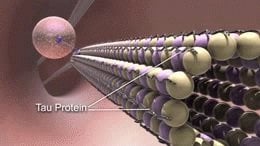A structure called “the microtubule network” is a crucial part of our nervous system. It acts as a transportation system within nerve cells, carrying essential proteins and enabling cell-to-cell communications. But in neurodegenerative diseases like Alzheimer’s, ALS, and Parkinson’s, this network breaks down, hindering motor abilities and cognitive function.
Now Prof. Illana Gozes of Tel Aviv University’s Sackler Faculty of Medicine has developed a new peptide in her lab, called NAP or Davunetide, that has the capacity to both protect and restore microtubule function. The peptide is a compound derived from the protein ADNP, which regulates more than 400 genes and is essential for brain formation, memory, and behavior.
Prof. Gozes and her team of researchers, including Dr. Yan Jouroukhin and graduate student Regin Ostritsky of TAU, observed that in animal models with microtubule damage, NAP was able to maintain or revive the transport of proteins and other materials in cells, ameliorating symptoms associated with neurodegeneration. These findings, which were reported in the journal Neurobiology of Disease, indicate that NAP could be an effective tool in fighting some of the most debilitating effects of neurodegenerative diseases.

Prof. Gozes is the director of TAU’s Adams Super Center for Brain Studies and holds the Lily and Avraham Gildor Chair for the Investigation of Growth Factors.
Securing passage through the brain
In their investigation, the researchers used two different animal models with microtubule damage. The first group was made up of normal mice whose microtubule system was broken down through the use of a compound. The second group were genetically-engineered mouse models of ALS, in which the microtubule system was chronically damaged. In both groups, half the mice were given a single NAP injection, while the control half were not.
To determine the impact of NAP on nerve cell communications, the researchers administered the chemical element manganese to all animal models and tracked its movement through the brain using an MRI. In the mice treated with NAP, researchers observed that the manganese was able to travel through the brain normally — the microtubule system had been protected from damage or restored to normal use. Those mice that did not receive the peptide experienced the usual breakdown or continued dysfunction of the microtubule system.
These findings were corroborated by a subsequent study conducted in the UK, published in the journal Molecular Psychiatry, which found that NAP was able to ameliorate damage in fruit fly models of microtubule deficiency, repairing nerve cell dysfunction.
Slowing down cognitive dysfunction
NAP appears to have widespread potential in terms of neuroprotection, says Prof. Gozes, who was recently awarded the Meitner-Humblodt Research Award for her lifelong contribution to the field of brain sciences.
Previous studies on the peptide, conducted through a collaboration between Allon Therapeutics and Ramot, TAU’s technology transfer arm, have shown that patients suffering from cognitive dysfunction — a precursor to Alzheimer’s Disease — showed significant improvements in their cognitive scores when treated with NAP. Additional studies have also shown that NAP has a positive impact on rectifying microtubule deficiencies in schizophrenia patients.
Prof. Gozes notes that more research must be conducted to discover how to optimize the use of NAP as a treatment, including which patients can benefit most from the intervention.
Notes about this neurology research
Contact: George Hunka – American Friends of Tel Aviv University
Source: American Friends of Tel Aviv University press release
Image Source: The microtubule disintegration image is credited to the US Government and is in the public domain.
Original Research: Abstract for “NAP (davunetide) modifies disease progression in a mouse model of severe neurodegeneration: Protection against impairments in axonal transport” by Yan Jouroukhin, Regina Ostritsky, Yaniv Assaf, Galit Pelled, Eliezer Giladi and Illana Gozes in Neurobiology of Disease. Published online June 2013 doi: 10.1016/j.nbd.2013.04.012
Full open access research for “NAP (davunetide) rescues neuronal dysfunction in a Drosophila model of tauopathy ” by S Quraishe, C M Cowan and A Mudherin Neurobiology of Disease. Published online April 16 2013 doi: 10.1038/mp.2013.32






